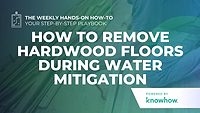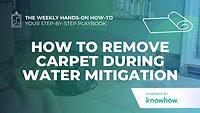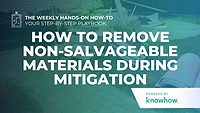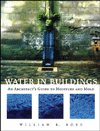Weekly Hands-on How-To powered by KnowHow
How To Remove Laminate Floors during Water Mitigation
A Step-by-Step guide to Efficiently Remove Laminate Floors During Water Mitigation

All images provided by KnowHow
Removing laminate flooring during water mitigation is one of those tasks that may seem simple on the surface, but it’s packed with steps that require care, precision, and the right tools. Whether you’re dealing with a small section of flooring or an entire room, this process is essential to stop further water damage and prepare the space for proper drying or restoration.
In this weekly how-to, powered by KnowHow, we’ll guide you through the step-by-step process of removing laminate flooring safely and efficiently. From prepping your tools to cleaning up the workspace, you’ll learn everything needed to handle this task with confidence.
Ready to roll up your sleeves and make that laminate a thing of the past? Let’s dive in!
Step 1: Gather Materials
Start by assembling all the tools and safety gear you'll need for the job. This includes a utility knife, a drill with screwdriver attachments, a pry bar, a hammer, protective gloves, safety goggles, and garbage bags. Clearing the work area of furniture and obstacles is equally essential, as it ensures you have a clean and safe space to work efficiently.
Step 2: Remove All Trim, Baseboards, and Transition Strips
To prepare for laminate removal, carefully detach all trim, baseboards, and transition strips. A pry bar or other suitable tool will help you gently pry them off without damaging the walls or surrounding surfaces. For transition strips, you may also need to remove the track fastened to the floor. If caulk is present where the trim meets the wall, use a utility knife to score the joint before prying.

Step 3: Start in a Corner
Identify a corner of the room away from any doorways as your starting point. Use a utility knife to cut through the edge of the laminate flooring near the wall, creating a clean entry point to begin lifting the flooring. This initial cut will make it easier to slide tools underneath the planks for removal.
Step 4: Use the Pry Bar
With your starting edge established, slide a pry bar under the cut laminate and gently lift it up. Most laminate floors are "floating" and held together by tongue-and-groove sides, which will separate into single pieces as you pull them up. If you encounter glued-down laminate, the process will require more effort and patience to separate the flooring without damaging the subfloor.
Step 5: Remove the Laminate Planks
Once a section is loosened, carefully lift and remove the planks, working row by row until the floor is completely cleared. As you go, place the removed planks into garbage bags to keep the workspace tidy and simplify disposal later.

Step 6: Dispose of the Flooring
After the removal is complete, clean the area thoroughly to eliminate any leftover debris or adhesive remnants. Bag up the flooring for proper disposal at a designated waste facility, or consider recycling it to reduce environmental impact. Leaving the area clean and clear ensures it's ready for the next phase of mitigation or restoration.
Out with the Old, In with the New
Removing laminate flooring may not be the most glamorous part of restoration work, but it’s a critical step in tackling water damage and preparing a space for the next phase of recovery. By following this process, you ensure the job is done efficiently, safely, and with minimal disruption to the rest of the property.
But let’s face it—keeping every step straight when you’re juggling multiple tasks can feel overwhelming. That’s where KnowHow comes in. With KnowHow, you can equip your team with detailed, step-by-step guides and instant on-the-job support, all tailored to your company’s SOPs. Whether you're in the office or on-site, KnowHow makes sure your processes are clear, consistent, and easy to follow.
Streamline your workflow and set your team up for success with KnowHow. Visit tryknowhow.com to see how we can help you simplify every step of your restoration projects.
Looking for a reprint of this article?
From high-res PDFs to custom plaques, order your copy today!








